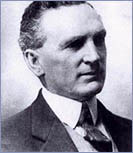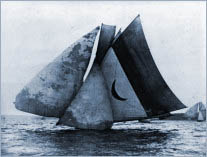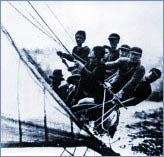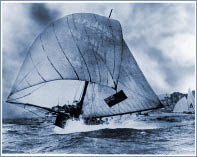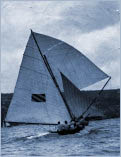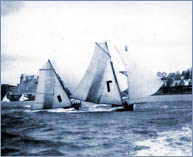|
Historical
- the beginning | ||||
|
Foy was a local businessman who loved sailing and believed Sydney Harbour to be the world�s best aquatic playground, and was disappointed that, unlike many other sports, sailing attracted practically no public interest. He was quick to realise that the sailors themselves were responsible for this lack of interest as they made no attempt to cater for the public.
Determined to change this situation, he discussed the matter with a few close friends and came up with a series of initiatives which he believed would popularise sailing as an exciting spectator sport. His plan was split into three simple steps: 1. Racing must be exciting and faster. 2. Boats had to be more colourful and more easily identified than by a number on the Sails. 3. Race winner should be decided on a first-past-the-post basis. The major problem with Foy�s plan was producing a faster racer, but he solved this with the first of the 18-footers, which was an open, centreboard boat with a very light hull, an 8-foot (2.4m) beam and only 30 inches (76cm) amidships. It carried a crew of 14 (compared to the previous boats with 25 crew) and had a huge spread of sail which gave it a sensational aquaplaning speed downwind. Foy�s original idea of having striped sails to identify each boat had to be abandoned due to the excessive cost of manufacturing varying designs for registration. His alternative was for each boat to have a colourful emblem on its mainsail - a tradition which continues to this day, although the colourful emblem is now almost exclusively the logo of a corporate sponsor. When Foy tried to enter his boats with the Anniversary Regatta Committee of 1892, they were rejected as the committee believed that 'such badges were not in keeping with the dignity of the oldest regatta in the southern hemisphere'. Foy was furious and announced 'we�ll run our own regatta on Anniversary Day. I�ll pay for it and we�ll give the public what it wants'. High-pressure publicity given to Foy�s plans paid big dividends. On regatta day, Clark Island (Sydney Harbour) was packed to capacity, while moored ferries and jetties provided additional accomodation - as did every vantage point along the foreshores of Sydney Harbour. The crowd was without precedent in Australian yacht racing although most of these spectators knew little about the sport. The vast majority were there to thrill to the excitement that Foy had promised. A triangular three miles course was plotted and a 'staggered' start introduced (where the best boats started after the slower boats) to bunch the fleet for a spectacular, downwind run to the finish at Clark Island. At the start there had been less than three minutes between all boats in the fleet. At the finish there were a dozen boats racing for the line in a bow-to-bow finish. The public got its moneys worth and the coloured badges of the 18-footers were an instant success. Foy had demonstrated that 18-footer racing was the most exciting sport ever seen on Sydney Harbour - a status that has never been seriously challenged. | ||||
|
| ||||
|
These �big boats� carried crews of 18-25 crewmen and had enormously heavy spars and gear. | ||||
|
| ||||
|
These 18-footers were dinghy type boats and carried mainsail, ballooner, ringtail, topsail, topsail head spinnaker and (at times) watersails. For spectators, they didn�t differ much from the bigger boats but were much less costly to build and maintain. The class was put onto a much firmer basis when the first official Australian Championship was conducted in Sydney during the 1912-13 Season. | ||||
|
| ||||
During this period there were tremendous sail carriers. Argument amongst 18-footer supporters as to the largest sail area ever carried will never end however one of the biggest must certainly be ZANITA, which was sailed by Bill 'Plugger' Martin. In 1910 she carried approximately 3500 square feet of sail. Her mainsail was 32 feet on the boom, her sails included mainsail, ringtail, topsail, ballooner, water sail and spinnaker. In the early 1930s, the fleet began to dwindle when rising costs and the difficulty of maintaining big crews made owners reluctant to replace old boats with new ones. Radical experiments had begun as designers began to apply the principles of aerodynamics to boat building. Arguments developed over the merits and otherwise of a new 7-foot beam conventional 18-footer named SCOT. It was generally dismissed as a passing fad. A Queensland owner named Frederick Hart was one of its few supporters and argued so strongly that his opponents challenged him to build this 'miracle boat'. In Brisbane, Hart worked out rough plans and specifications which he passed on to boat builder H.P. Whereats to finalise.
| ||||
|
The success of this new concept was the beginning of the end for the �big boats� but the Sydney Flying Squadron club refused to register these new narrow beam boats for their local sailors. A group of sailors wanting these smaller boats held several meetings to consider the possibility of forming their own club to cater for such boats. In January 1935 this led to the formation of the N.S.W. 18-footers Sailing League (now known as the Australian 18-footers League). The new club�s first race was the first heat of the 1935 Australian Championship. Six new 7ft beam skiffs joined the club�s fleet for the 1935-36 Season. To show the popularity of these new boats, a further seven new craft were added to the register during the 1936-37 Season. By the 1938-39 Season there were 21 boats racing with the �League�. `During these �heady� times there were seven ferries following the race every Sunday. Each carried a commentator, manager, and other officials - one of whom was stationed in the wheel house of each steamer to help the captain decide where to go to get the best possible view for the people on board. This period is best summed up by the following comments written by the �League� president at the beginning of the 1938-39 Season: 'There can be no doubt that the modern type 18-footer appeals to the sporting instincts of every Australian as is evidenced by the fact that our patrons increase in numbers as each season progresses. Two seasons ago we felt proud of being able to record 150,000 patrons for the season. Last season we were just under the 200,000 mark'. (The initial success of the club continues today. It is the world leader in the promotion and development of the class into a truly international sport). In 1937 Mr. James J. Giltinan (Secretary of the N.S.W. 18-footers Sailing League) planned a World�s Championship for 18-foot open boats on Sydney Harbour to coincide with Sydney�s 150th Anniversary in January 1938. Advertisements were placed in major newspapers throughout the world and replies received from England, USA, Hong Kong and New Zealand. Unfortunately, due to the unsettled atmosphere in Europe at the time only the New Zealanders were able to compete. The carnival was a great success. The degree of success can be measured by the article which appeared in the �Sydney Morning Herald� newspaper on the day following the first heat: 'The crowd at Circular Quay (ferry wharf) was so large that extra steamer accomodation had to be provided at the last moment, while craft of almost every conceivable description were in attendance. The foreshores were thronged with spectators'. The total crowd was estimated at more than 10,000 people. When World War II broke out, the authorities in Sydney stopped the League racing on the main harbour so they continued their races on the �river� courses (west of the Sydney Harbour Bridge) until early 1946. Following the war years, there was a move in Queensland to build smaller beam boats with smaller sails and reduced crew numbers. This was understandable as their fleet of �7ft Beam� boats was diminishing and new boats were not being built. Increased costs was another factor. In 1946, Queensland delegates approached the League to accept the new 6-foot beam concept 18-footers so that the Australian Championship competition could continue. League boat owners and members had to decline as they had considerable money invested in their 7-foot beam boats and to change so drastically would be far too costly. Queensland turned to the Sydney Flying Squadron to continue the Australian Championship with the 6-foot beam boats while the League continued to race the 7-foot beamers for another 5 years. | ||||
|
| ||||
|
| ||||
|
|
